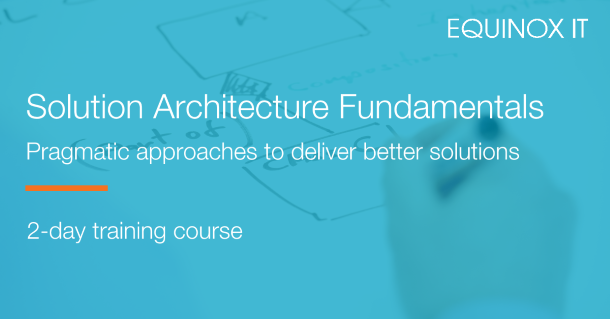Solution Architecture Fundamentals
Broaden your solution architecture skills, become more aware of the key solution architecture practices and standards, and deliver better solutions.
Description

This two-day course is aimed at practising solution architects, including those who may be new to the role or those engaging with solution architects. It's relevant regardless of whether your solution is built in Java, .NET, you are implementing a package solution, or integrating existing systems. Its principles and themes are just as applicable to developing solutions and situations where commercial off-the-shelf (COTS) products will be integrated.
The course provides a pragmatic approach to delivering solution architecture.
This is an interactive course designed and delivered by practising solution architects.
With a combination of presentation, group discussion and group exercises, you will put into practice what you have learned by applying solution architecture to a case study.
For groups of five or more, please contact us to discuss hosting a private course in-house at your place.
Outline
Introduction
- What is architecture and types of architecture
- Architecture vs. design
Solution Architecture – Roles and Responsibilities
- The role and skills of a solution architect in a project team
- Relationship between solution architects and project managers, designers or other team members
- Solution architect within iterative and agile implementation projects
Defining a solution architecture
- The drivers and constraints of a solution architecture
- Solution architecture for off the shelf packages vs developed software
- How functional and non-functional requirements drive solution architecture
- Applying architectural principles
Sharing solutions architecture
- How to communicate solution architecture
- Who needs to know about your architecture?
- Evaluating your architecture
Modelling
- Context diagram (to clearly delineate scope)
- High level component (“boxes and lines”) diagram to identify major logical components
- Sequence diagrams to model behavioural aspects of the system and component interactions
- Data models to show key data entities
- Deployment diagram to model physical deployment into an infrastructure
- Introduction use-case diagrams
Learning outcomes
Following the completion of this course, you will have:
- An understanding of what solution architecture is all about.
- An understanding of what it means to be a solution architect and the responsibilities associated with the role.
- An understanding of the trade-offs that are made when making architectural decisions.
- Experience of how to define the solution architecture; including defining non-functional requirements, determining the architectural drivers, and identifying the architectural constraints.
- The ability to identify stakeholders and understand their solution architecture needs.
- An understanding of architectural view points and perspectives.
Audience
- Architects
- Project managers
- Analysts
- IT managers
Prerequisites
Experience in implementing technology solutions